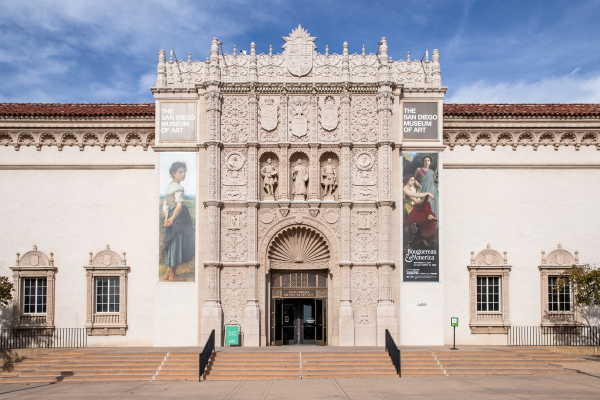

Himachal Pradesh, Pahari, Kangra, circa 1785
Opaque watercolor painting and gold on paper
7 3/32 x 10 7/8 in (18 x 27.6 cm)
Provenance:
Ramesh Kapoor, New York, New York ( – March 7, 1985 )
Edwin Binney 3rd, San Diego, California ( March 7, 1985 – August 27, 1990 )
San Diego Museum of Art, San Diego, California ( August 27, 1990 – )
Exhibited:
Myths, Monsters, Maharajas: Introducing the Binney Collection, San Diego Museum of Art, 11/23/1991 – 1/26/1992
The Universe: Constructing the Cosmos in the Religious Arts of Asia, Pacific Asia Museum, 2/3/2001 – 5/6/2001
Visions of the Cosmos: From Milky Ocean to Black Hole, , 12/11/2009 – 5/10/2010
Epic Tales from India: Paintings from The San Diego Museum of Art, The San Diego Museum of Art, 11/19/2016 – 6/12/2018
When the forces of evil were becoming powerful, the gods came to Vishnu for help. Vishnu, the presrver of the Cosmos, devised the scheme of churning the Ocean of Milk to obtain amrta, which would sustain the gods and make them immortal. The holy mountain Mandara, with Vishnu seated atop it, was carried to the ocean and placed as the churning stick on the back of Kurma, the king of tortoises, an incarnation of Vishnu himself. The serpent king Vasuki served as the churning rope, the demons pulling on his hood, the gods his tail. Into the radiant waters of the Ocean of Milk were thrown various kinds of medicinal herbs, and the churning began.
After the gods and demons had labored at their task for a thousand years, miraculous things arose from the water one by one. The first was the all-destroying world poison, which out of compassion Shiva drank. On seeing her husband in danger, Uma pressed his throat, and the poison remained there forever. (The painting does not include this phase of the myth.) Then arose the wish-fulfilling cow Surabhi, the fountain of milk, first sustenance of the human race. Then came Sura, the deity of wine, carrying two golden pots full of liquor. Next from the whirlpool of the deep came the celestial Parijata tree, symbol of all lovely flowers and precious fruits with which the earth is blessed. Then emerged the crescent moon and a bow which were seized by Shiva. Then appeared Lakshmi, also called Shri, carrying a lotus. Lakshmi adored Vishnu, while the demons, enraptured with her beauty, desired to passess her.
Lakshmi was followed by the seven-headed horse, and then the gleaming gem Kaustubha, on a golden chain. Next arose Airavata, the four-tusked elephant, which Indra took for himself. Then came Dhanvantari, the divine physician bearing in his hand a golden cup filled with amrta, the elixir of immortality. The titans fought agains the gods for the possession of the amrta and the lovely goddess Lakshmi. Vishnu assumed the form of Mohini, a beautiful woman, and so chamed the titans that they presented the amrta to her. Vishnu immediately gave it to the gods, who thus became immortal.
————–
Pahari paintings vary depending on where they were made, but those produced in and around the region of Kangra display a preference for cool colors rather than the robust reds and vibrant yellows of most Rajasthani paintings.
This image depicts Vishnu atop the holy mountain Mandara, which the gods and the demons use to churn the Ocean of Milk in order to obtain a special nectar that will render the gods immortal. The mountain is balanced on the back of a giant tortoise called Kurma, and is being turned with the body of the serpent king. In the water and on the grass above appear the many marvelous objects produced from the ocean’s depths—including a wish?fulfilling cow, a celestial tree, the crescent moon, a bow, the goddess Lakshmi, a seven-headed horse, the gleaming gem known as Kaustubha, a four-tusked elephant, and the divine physician Dhanvantari holding a cup filled with the nectar of immortality.